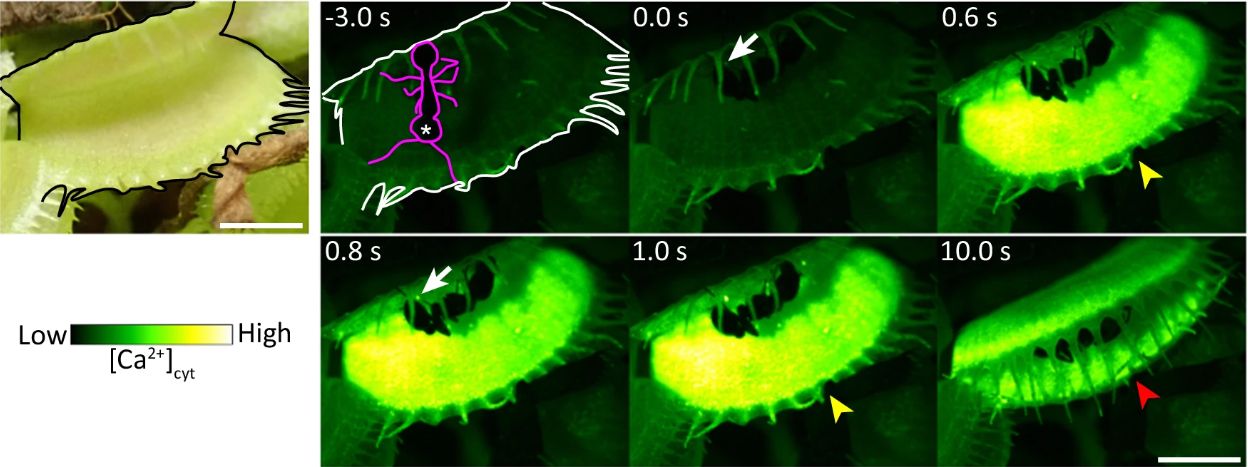Science
New Mechanosensor Reveals Secrets of Venus Flytrap’s Speed

Recent research has unveiled critical insights into how the Venus flytrap, a remarkable carnivorous plant, detects and captures its prey. A study led by Hiraku Suda and colleagues, published in Nature Communications, identifies a mechanosensor known as DmMSL10 that plays a pivotal role in the plant’s rapid response to stimuli.
The Venus flytrap (Dionaea muscipula) employs a sophisticated mechanism to ensnare unsuspecting insects. Its leaves are lined with sensitive hairs that respond to touch. When these hairs are triggered, calcium ions are released, which are essential for the plant’s action potential and, ultimately, its ability to trap prey. While this process has been known, the precise mechanism remained unclear until now.
Understanding the Mechanism Behind Venus Flytrap’s Touch Sensitivity
Suda’s team conducted experiments by creating a variant of the Venus flytrap that lacks the DmMSL10 channel, which is a stretch-activated chloride ion (Cl–) channel. They found that while both the wild-type and knockout variants responded to mechanical stimulation, the knockout variant exhibited a significantly lower rate of action potential generation. In contrast, the wild-type variant continued to produce action potentials even after the initial stimulation had ceased.
This discovery indicates that the DmMSL10 mechanosensor is critical for interpreting slight movements, enhancing the plant’s ability to detect prey effectively. Subsequent tests involved allowing ants to walk across the leaves of both variants. The wild-type plant successfully captured the first ant, while the knockout variant failed to respond, underscoring the importance of the mechanosensor in prey detection.
Implications for Future Research
The findings from this research contribute to a deeper understanding of how plants like the Venus flytrap generate long-range calcium signals. These signals are crucial for coordinating the rapid movements necessary to capture prey, which is vital for the plant’s nutrient acquisition.
This study not only sheds light on the unique adaptations of the Venus flytrap but also opens avenues for further investigation into the evolutionary parallels between plant and animal mechanosensory systems. Researchers anticipate that continued studies will provide more clarity on the evolutionary development of these mechanisms, potentially offering insights into broader biological phenomena.
With this new understanding, the Venus flytrap’s remarkable ability to respond to its environment becomes even more impressive, showcasing the intricate relationships between plants and their ecosystems.
-

 Business4 days ago
Business4 days agoInvestors Eye Potential $60,000 Gains with Ozak AI Token
-

 Politics5 days ago
Politics5 days agoFormer Pastor Arrested on Human Trafficking and Indecent Charges
-

 Business5 days ago
Business5 days agoQuotient Wealth Partners Adjusts Holdings in iShares Russell 1000 ETF
-

 Lifestyle5 days ago
Lifestyle5 days agoNatty from KISS OF LIFE Stuns in Micro-Shorts at Seoul Event
-

 Politics4 days ago
Politics4 days agoSkip Bayless Critiques Travis Hunter’s Game Day Baptism
-

 Entertainment5 days ago
Entertainment5 days agoUtah Residents Face Resource Shortages Amid Ongoing Government Shutdown
-

 Business5 days ago
Business5 days agoCalifornia to Ban All Plastic Bags in Grocery Stores by 2026
-

 Entertainment5 days ago
Entertainment5 days agoPete Davidson Surprises Pregnant Girlfriend with Private Jet to Concert
-

 Politics5 days ago
Politics5 days agoIberia Parish Sees Surge in Marriage Licenses Issued in October
-

 Entertainment5 days ago
Entertainment5 days agoAce Frehley, KISS Guitarist, Passes Away at 74 After Fall
-

 Science5 days ago
Science5 days agoCommunity Mourns Loss of Judith Ernst, Pioneer Educator at 81
-

 Entertainment6 days ago
Entertainment6 days agoEastside Kings Festival Celebrates Austin’s Rich Blues and Jazz Heritage









